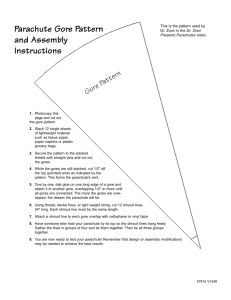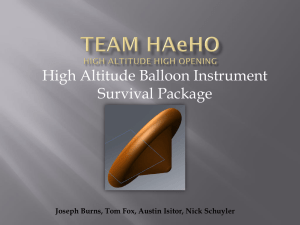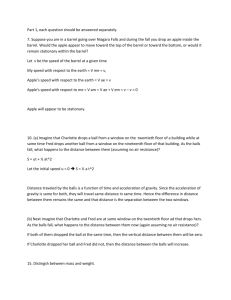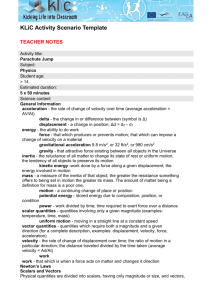Parachute Design
advertisement
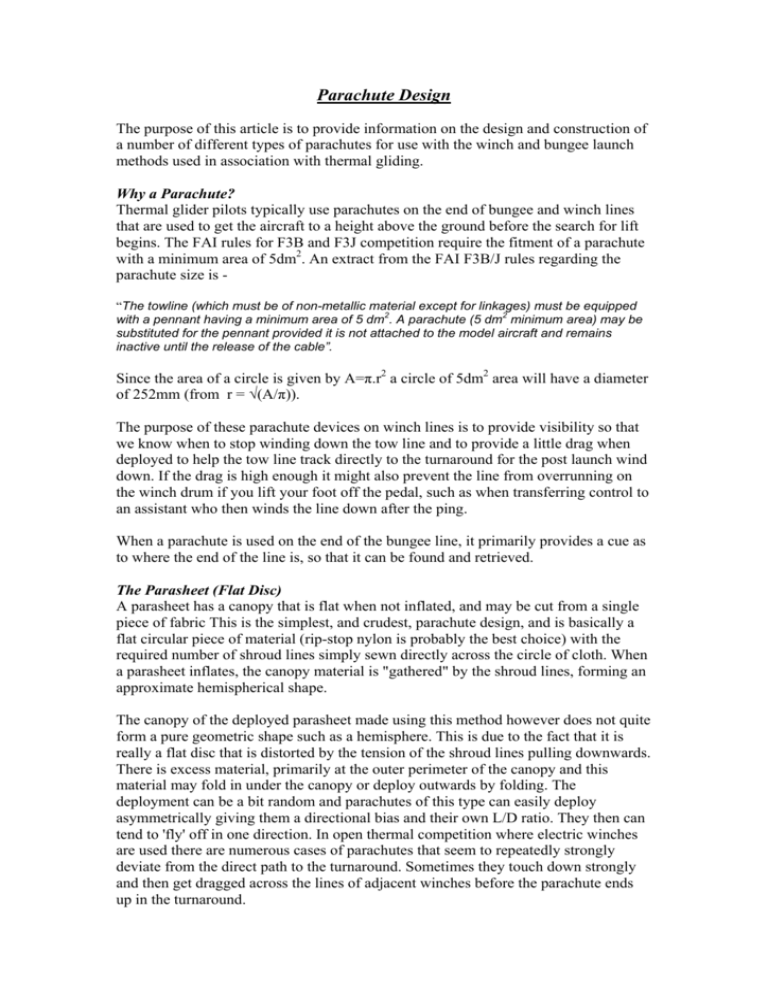
Parachute Design The purpose of this article is to provide information on the design and construction of a number of different types of parachutes for use with the winch and bungee launch methods used in association with thermal gliding. Why a Parachute? Thermal glider pilots typically use parachutes on the end of bungee and winch lines that are used to get the aircraft to a height above the ground before the search for lift begins. The FAI rules for F3B and F3J competition require the fitment of a parachute with a minimum area of 5dm2. An extract from the FAI F3B/J rules regarding the parachute size is “The towline (which must be of non-metallic material except for linkages) must be equipped with a pennant having a minimum area of 5 dm2. A parachute (5 dm2 minimum area) may be substituted for the pennant provided it is not attached to the model aircraft and remains inactive until the release of the cable”. Since the area of a circle is given by A=π.r2 a circle of 5dm2 area will have a diameter of 252mm (from r = √(A/π)). The purpose of these parachute devices on winch lines is to provide visibility so that we know when to stop winding down the tow line and to provide a little drag when deployed to help the tow line track directly to the turnaround for the post launch wind down. If the drag is high enough it might also prevent the line from overrunning on the winch drum if you lift your foot off the pedal, such as when transferring control to an assistant who then winds the line down after the ping. When a parachute is used on the end of the bungee line, it primarily provides a cue as to where the end of the line is, so that it can be found and retrieved. The Parasheet (Flat Disc) A parasheet has a canopy that is flat when not inflated, and may be cut from a single piece of fabric This is the simplest, and crudest, parachute design, and is basically a flat circular piece of material (rip-stop nylon is probably the best choice) with the required number of shroud lines simply sewn directly across the circle of cloth. When a parasheet inflates, the canopy material is "gathered" by the shroud lines, forming an approximate hemispherical shape. The canopy of the deployed parasheet made using this method however does not quite form a pure geometric shape such as a hemisphere. This is due to the fact that it is really a flat disc that is distorted by the tension of the shroud lines pulling downwards. There is excess material, primarily at the outer perimeter of the canopy and this material may fold in under the canopy or deploy outwards by folding. The deployment can be a bit random and parachutes of this type can easily deploy asymmetrically giving them a directional bias and their own L/D ratio. They then can tend to 'fly' off in one direction. In open thermal competition where electric winches are used there are numerous cases of parachutes that seem to repeatedly strongly deviate from the direct path to the turnaround. Sometimes they touch down strongly and then get dragged across the lines of adjacent winches before the parachute ends up in the turnaround. The assembly of a parasheet design is not much more difficult than cutting a circle of cloth of the required diameter and then sewing the shroud lines on. With some planning it can be arranged so that the shroud line is one continuous length and this reduces the number of shroud line joins to just one. Metal loops can also be included at the sewing phase. One provided above the canopy to act as a tow ring and a lower one for fixing to the winch line. The shrouds should be on the outside of the canopy so that they contain the material which is trying to expand outwards with the pressure of the captured air. A Hemispherical Parachute Canopy A more efficient and proper parachute is one where the deployed canopy takes on the shape of a hemisphere. To form a parachute that deploys as a hemisphere, it is necessary to take the desired three dimensional hemispherical shape and divide it into a number of two dimensional panels, called gores. Each gore is individually cut to a specific shape so that when re-assembled it will form a hemisphere upon deployment. To enable me to be able to create plots for different sizes of parachute, with a different number of gores I developed an Excel spreadsheet to do all the numerical calculations. I simply change some parameters such as the number of gores, base diameter and elliptical ratio (more on that later) and the appropriate plots are produced. For example 80 60 40 20 0 0 20 40 60 80 100 120 140 160 180 200 -20 -40 -60 -80 Diagram 1 - Gore pattern for 6 gore 252mm dia hemispherical parachute The diagram above shows a single gore panel for a six panel hemispherical parachute canopy that is 252mm in diameter at the base and 126mm high. Six of these gore panels need to be made and assembled to form the parachute. An interesting point to note is that the angle subtended on the left hand side of the pattern is 60 degrees (1/6 of 360 degrees) so that when all six gores are joined they complete the 360 degree circle. Also note that the two edges of the gore at the right hand side are parallel. These two edges are at the lower perimeter of the hemisphere and the lines here will be vertical on the resultant hemispherical canopy. The parachute canopy that results will still not be quite a perfect hemisphere since it comprises a relatively small number of two dimensional gores. A closer to perfect result can be achieved by constructing a parachute with more gores. However more gores equals more sewing for assembly and for winch/bungee purposes true perfection in the parachute canopy profile is not absolutely required. To minimise the number of gores to be joined it is possible to make a canopy with only four panels, but with fewer panels the final canopy shape will deviate more and more from the ideal shape. The shape of each gore will be different to the one shown above. 100 80 60 40 20 0 0 20 40 60 80 100 120 140 160 180 200 -20 -40 -60 -80 -100 Diagram 2 - Comparison of 4 gore, 6 gore and 8 gore panels The relative size difference of each gore for a four gore, six gore and an eight gore hemispherical parachute are shown for comparison in the diagram above. The parachute diameter is 252mm for all cases. Hemispherical parachutes actually use less material in the assembled parachute than the parasheet type and as a result should be a little lighter than the parasheet type of equivalent diameter. An Elliptical Parachute Canopy A further development of the hemispherical parachute is a parachute with an elliptical shape to its canopy profile. This is a logical progression since geometrically the hemispherical and the elliptical canopies are closely related. A circle is really only a special case of the ellipse, where the long axis and the short axis are of equal length. Equations allowing the calculation of many of the characteristics of an ellipse are quite complex. For example the equation to calculate the perimeter of an ellipse is a sum of a series with an infinite number of terms. There is a formula that is an imperfect approximation, and this is what I have used. Imperfect here implies an error of less than 0.3%. The simplified equation I use is certainly accurate enough for our purposes. x2 / a 2 + y 2 / b2 = 1 Diagram 3 - An ellipse with an a/b ratio of 0.707 For the parachute with an elliptical canopy profile I have labelled the two axes ‘a’ and ‘b’, the ‘height’ and the ‘radius’, respectively. For an elliptical parachute canopy we just set the desired height:radius ratio in the spreadsheet and a new gore shape is derived. A parachute with an elliptical canopy has essentially the same Cd as a hemispherical parachute or a parasheet of the same deployed diameter. So there is no drag penalty in selecting an elliptical parachute profile. 140 140 120 120 100 100 80 80 60 60 40 40 20 20 0 -130 -110 -90 -70 -50 -30 -10 -130 -110 -90 -70 -50 -30 -10 0 10 30 50 70 90 110 130 10 30 50 70 90 110 130 Diagram 4 - A parachute canopy profile for different height:radius ratios Above is a diagram showing the relative shapes of the canopies for hemispherical, 0.7 elliptical and 0.5 elliptical parachute canopies, all of 252mm diameter. 80 60 40 20 0 0 20 40 60 80 100 120 140 160 180 200 -20 -40 -60 -80 Diagram 5 - Comparison of gore shapes for different height:radius ratios A diagram showing three types of gores is shown above. The largest gore is for the six gore hemispherical (height:radius=1) 252mm diameter six gore parachute discussed above. The next is one for a six gore elliptical canopy parachute where the ratio of height:radius is 0.707 (1/sqrt(2)), leading to a parachute height of 99mm and the smallest gore is for a six gore elliptical parachute where the height:radius ratio is 0.5 and so it is only 63mm high. Note that irrespective of the canopy shape the angle subtended at the centre remains the same at 60 degrees and the edges at the outer perimeter are always parallel. From the above diagram you can see that lower elliptical ratios lead to smaller gores, and consequently less material, for a parachute of the same deployed diameter. This results in lighter parachutes, if constructed using equivalent materials. Less loose material flapping about under the aircraft when launching should result in lower drag during the climb phase too. In practice, because there are a finite number of shrouds under tension and the fact that the shroud lines converge at a common central point directly below the canopy this means that the canopy can never exactly attain the perfect shape. Construction Construction of hemispherical or elliptical parachutes is more complex as the multiple gores need to be accurately sewn together if anything close to the desired canopy shape is to be produced, and the shroud lines need to be included in the joins between the gores. The fact that multiple gores are required opens up the option of multiple colours in the assembled parachute. Depending on what colours are available in your chosen material, you could select alternating bright fluorescent colours, our national colours, the colours of your favourite football team or whatever takes your fancy. Keep in mind though that brighter and contrasting colours are easier to see. For bungee use avoid greys, greens and browns as these are the traditional camouflage colours and even if the parachute descends onto the field it still could be difficult to locate. This is not necessarily an issue for winch line parachutes as these are usually wound down into the turnaround. However visibility for winch line parachutes could be an issue if there is a line break and your parachute goes drifting off downwind and lands some distance away. Similar to the parasheet type parachute, the rings at the top and bottom can be included when constructing the parachute and it is theoretically possible to use a continuous single length of shroud line, but this can be quite tricky to actually achieve. I used fluoro coloured builders line as the shroud line material in an eight gore parachute. I used eight separate lengths of line for the shroud and then after having put them through the upper and lower rings, stitched and CA'd them together. More elegant methods exist no doubt. Also after many hours of exposure to the sun the fluoro colour in the shrouds has faded significantly. I have made both a hemispherical and a 0.7 ratio elliptical parachute. I find that both deploy reliably and track straight towards the turnaround on wind down. The weight saving achieved by using the elliptical design was only 3g. So the weight saving is real, but quite small. Some pilots prefer to have no metal rings in their parachute due to the risk of model damage should the parachute actually get struck by the aircraft on a steep zoom overrun. Parachute Stability Parachute stability is enhanced if the shroud lines are made longer below the canopy and conversely stability is reduced if they are shortened. A good starting point for shroud line length is for the shroud length below the lower perimeter of the canopy to be at least equal to the diameter of the deployed parachute canopy. Stability is also noticeably enhanced if a hole is provided in the top of the parachute canopy. Of course too large a hole will reduce the drag to a low level negating the purpose of having the parachute in the first place. Both my hemispherical and a 0.7 ratio elliptical parachutes have holes approximately 50mm in diameter at the top. This seems to work well. With parachutes used on bungees, care should be taken to minimise the weight of any hardware installed above the canopy. As the bungee parachute descends with virtually no line tension, any heavy items on top of the parachute, such as a heavy tow hook ring, will tend to tip the parachute to an inverted position, collapsing the canopy. References I did a quick internet search using Google for information about generic parachute design that I could apply to a winch parachute. I found that there wasn't too much relevant non-commercial information available. The best site I found that answered most of the questions I had was Richard Nakka's Experimental Rocketry Site which has a detailed page on parachute performance parameters and some formulae. The site is oriented towards model rocketry and the parachute page describes a large 1m diameter 12 gore parachute designed for high speed deployment in the recovery of a model rocket. It can be found at http://members.aol.com/ricnakk/paracon.html Another helpful site is http://www.cit.gu.edu.au/~anthony/kites/parafauna/chute_design/ which is oriented towards designing a parachute for descending a small stuffed toy. Disclaimer An appeal to common sense. Don't use this information to design or build a parachute into which you are going to strap yourself, your pet, or anything else like a brick or rock etc. and throw it from a high place hoping to see it float gently to earth. The rate of descent, the trajectory and the overall performance of the resultant parachute and payload combination is not guaranteed. Someone might get hurt.
